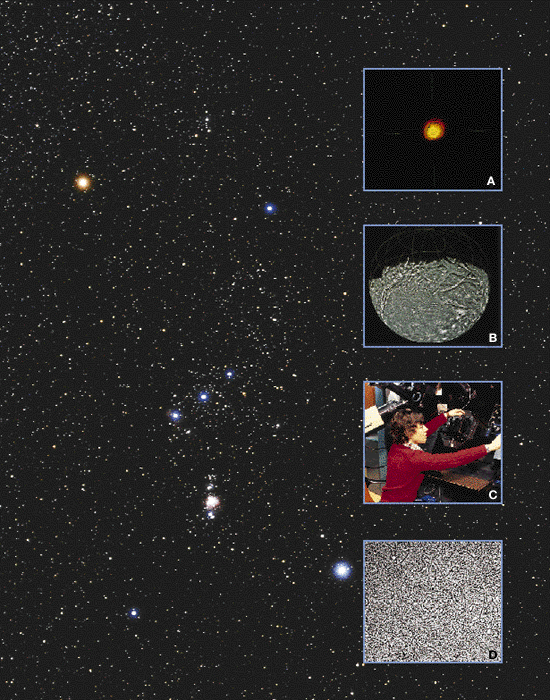
(Background) One of the most easily recognizable star fields in the winter nighttime sky, the familiar constellation Orion. This field of view spans roughly 100 light-years, or 1015 kilometers. (See also Figure 1.6.)
(Inset A) If we magnify the wide view of the Orion constellation, shown at left, by a million times, we enter into the realm of the largest stars, with sizes of about a billion kilometers. Such a star is seen in this false-color image of the red-giant star Betelgeuse (which is actually the bright star at the upper left of the Orion constellation).
(Inset B) Another magnification of a million brings us to the scale of typical moons—roughly 1,000 kilometers—represented here by Ariel, one of the many moons of Uranus.
(Inset C) With yet another million-times magnification, we reach scales of meters, represented here by an astronomer at the controls of her telescope.
(Inset D) At a final magnification of an additional million, we reach the scale of molecules (about 10-6 meter), represented by this coiled DNA molecule of a rat's liver.
Studying this chapter will enable you to:
Explain the concept of the celestial sphere and the conventions of angular measurement that enable us to locate objects in the sky.
Describe how the Sun, the Moon, and the stars appear to change their positions from night to night and from month to month.
Account for these apparent motions in terms of the actual motions of Earth and the Moon.
Show how the relative motions of Earth, the Sun, and the Moon lead to eclipses.
Explain the simple geometric reasoning that allows astronomers to measure the distances and sizes of faraway objects.
Nature offers no greater splendor than the starry sky on a clear, dark night. Silent and jeweled with the constellations of ancient myth and legend, the night sky has inspired wonder throughout the ages—a wonder that leads our imaginations far from the confines of Earth and the pace of the present day, and out into the distant reaches of space and cosmic time itself. Astronomy, born in response to that wonder, is built on two of the most basic traits of human nature: the need to explore and the need to understand. Through the interplay of curiosity, discovery, and analysis—the keys to exploration and understanding—people have sought answers to questions about the universe since the earliest times. Astronomy is the oldest of all the sciences, yet never has it been more exciting than it is today.